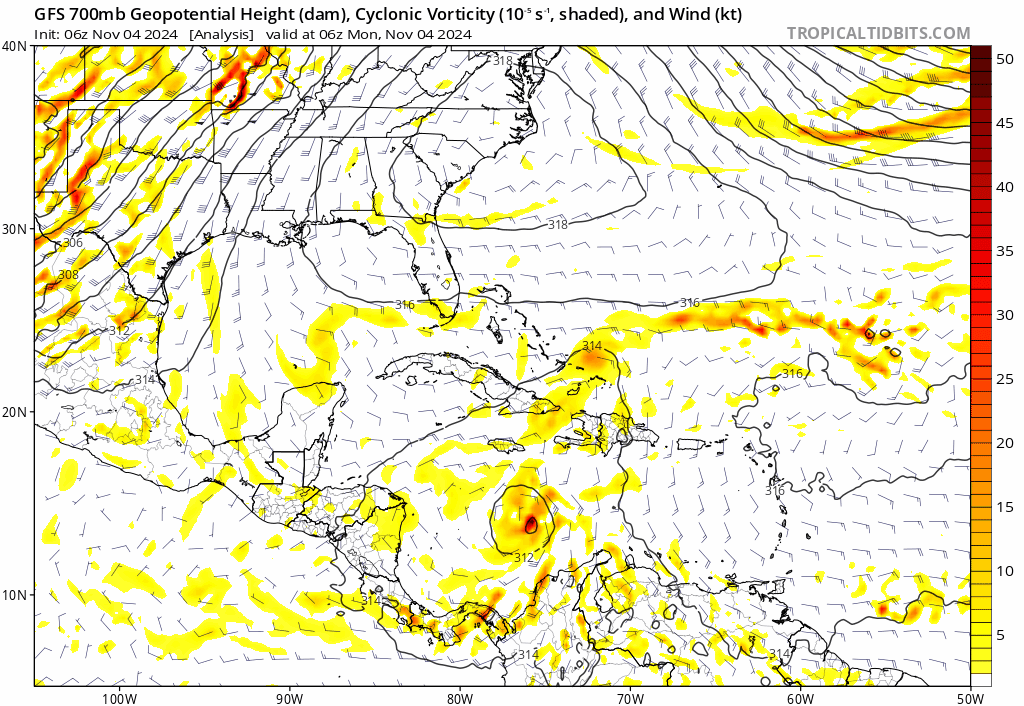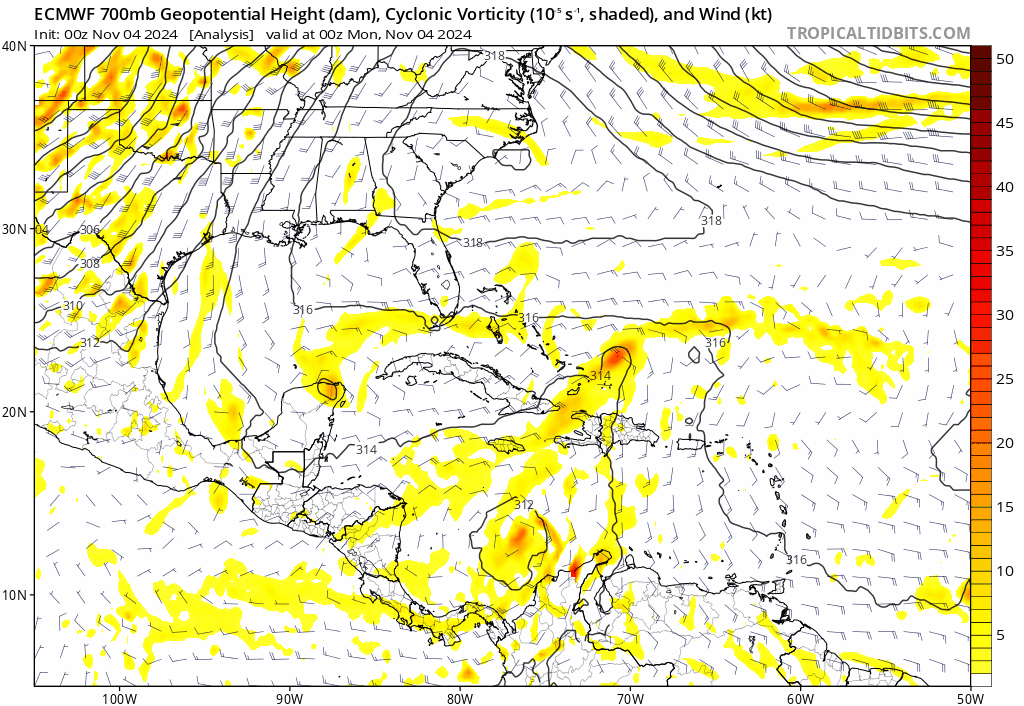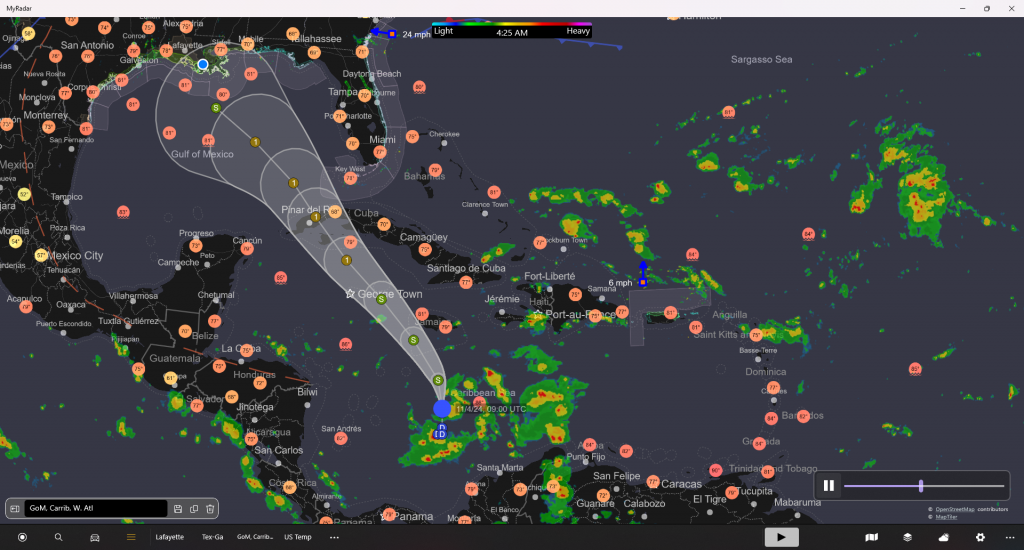There seem to be a bid of disagreement of the path and definite disagreement with the strength. There is a lot of shear in the Northern Gulf of Mexico which could cause the storm to dissipate as it approaches the Northern Gulf coast. However, this depends on what it does when it approaches the central Gulf. In all, I think this one may be one we need to pay attention to. As its future is not certain, we may have little time to make decisions and take precautions.
As of now, we can expect the arrival of tropical force winds Thursday morning around 8 am.





nhc.noaa.gov
000 WTNT43 KNHC 040850 TCDAT3 Potential Tropical Cyclone Eighteen Discussion Number 3 NWS National Hurricane Center Miami FL AL182024 400 AM EST Mon Nov 04 2024 The system's deep convection is gradually becoming better organized with a little more concentration of the shower and thunderstorm activity. However, convective banding features are not yet well defined, and observations from an Air Force Hurricane aircraft did not show a distinct circulation center. Surface observations and scatterometer data indicate very light winds over the western portion of the disturbance. Since the circulation has yet to become well defined, the system is still being designated as a potential tropical cyclone at this time. The current intensity estimate remains at 30 kt based on the scatterometer winds and the aircraft observations. Another Air Force plane is scheduled to investigate the system later this morning. Given the lack of a well-defined center, the initial motion is rather uncertain. My best estimate is slowly northward, or 360/6 kt. Over the next few days, the system should move generally northwestward on the southwestern periphery of a mid-level high pressure system near and east of the Florida peninsula. Later in the forecast period, the track guidance diverges significantly, with the latest ECMWF and U.K. Met office model predictions well to the southwest of most of the other guidance tracks. The motion during the latter part of the period is partially dependent on how much the mid-level subtropical ridge to the northeast is eroded by the upstream flow and how strong and vertically deep the tropical cyclone will become. The details of this evolution are not well known at this time. In any event it should be noted that, given the uncertainty in the center location, there is greater than usual uncertainty in the track forecast. As noted earlier, there is also significant uncertainty in the intensity prediction. For the next 48 hours or so, the system will be traversing waters of high oceanic heat content with low vertical wind shear. Therefore strengthening is likely, but the amount of intensification is largely dependent on whether a well-defined inner core and vertically aligned circulation develops. If this evolution occurs, which cannot be known with great certainty, significant intensification is likely before the system reaches Western Cuba. Later, the environment over the Gulf of Mexico should be less conducive for strengthening with strong southwesterly shear and drier air. The official intensity forecast lies between the more conservative statistical-dynamical guidance and the more aggressive regional hurricane models. Key Messages: 1. The disturbance is expected to become a tropical storm today and pass near Jamaica on tonight and Tuesday where a Tropical Storm Warning is in effect. The system is forecast to become a hurricane by Tuesday night and there is a risk of dangerous impacts from hurricane-force winds and storm surge in the Cayman Islands and portions of western Cuba. 2. Interests in Cuba and the Florida Keys should closely monitor this system as hurricane and tropical storm watches could be required for portions of these areas later today. 3. The system is forecast to enter the western Gulf of Mexico later this week, but given significant uncertainties in the long-range forecast track and intensity, it is too soon to determine what, if any, impacts could occur. Residents in this area should regularly monitor updates to the forecast. 4. The system will bring areas of heavy rain across portions of the Western Caribbean, including the island of Jamaica and portions of Cuba through mid-week. Flooding could occur over portions of Jamaica and Cuba, with mudslides possible. Heavy rainfall would then spread north into Florida and adjacent areas of the Southeast United States mid to late week. FORECAST POSITIONS AND MAX WINDS INIT 04/0900Z 14.2N 76.9W 30 KT 35 MPH...POTENTIAL TROP CYCLONE 12H 04/1800Z 15.5N 77.1W 35 KT 40 MPH...TROPICAL CYCLONE 24H 05/0600Z 17.3N 78.3W 45 KT 50 MPH 36H 05/1800Z 19.1N 79.9W 60 KT 70 MPH 48H 06/0600Z 20.8N 81.7W 70 KT 80 MPH 60H 06/1800Z 22.7N 83.4W 70 KT 80 MPH...INLAND 72H 07/0600Z 24.2N 84.7W 70 KT 80 MPH...OVER WATER 96H 08/0600Z 26.0N 87.0W 65 KT 75 MPH 120H 09/0600Z 27.5N 89.5W 55 KT 65 MPH $$ Forecaster Pasch
